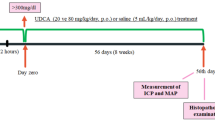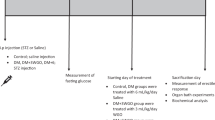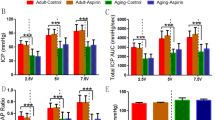Abstract
To investigate, if advanced glycation end products (AGEs) are involved in erectile dysfunction (ED) and also ALT-711, a cross-link breaker of AGEs, has the therapeutic potential against the development of ED in rats treated with high concentrated AGEs including food. For this purpose, 30 male Harlan Spraque-Dawley rats randomly were divided into three groups; (1) control rats treated with regular diet, (2) rats treated with high-level of AGE specific diet for 6 months, and (3) rats having AGE-diet treated with ALT-711 for the final 3 months of 6 months of AGE-diet period. Erectile response to cavernosal nerve stimulation (CNS), protein expression of neuronal nitric oxide synthase (nNOS) and levels of AGEs, Malondialdehyde (MDA), cyclic guanosine monophosphate (cGMP) were determined in penile tissues. Erectile responses to CNS and penile nNOS and cGMP content were significantly reduced, while AGEs and MDA were elevated in penises of Group-2. Treatment with ALT-711 reversed ED and depletion of both nNOS and cGMP. Additionally, ALT-711 treatment reduced penile tissue AGEs and MDA expression. In present study: rats without any co-morbidity such as diabetes mellitus (DM) and chronic renal failure (CRF) were treated with high-level AGEs containing food. Our results suggest that ALT-711 may be an interesting and promising approach in the treatment of AGEs-related ED.
This is a preview of subscription content, access via your institution
Access options
Subscribe to this journal
Receive 8 print issues and online access
$259.00 per year
only $32.38 per issue
Buy this article
- Purchase on Springer Link
- Instant access to full article PDF
Prices may be subject to local taxes which are calculated during checkout




Similar content being viewed by others
Change history
04 March 2022
A Correction to this paper has been published: https://doi.org/10.1038/s41443-022-00544-w
References
Seftel AD, Vaziri ND, Ni Z, Razmjouei K, Fogarty J, Hampel N, et al. Advanced glycation end products in human penis: elevation in diabetic tissue, site of deposition, and possible effect through iNOS or eNOS. Urology. 1997;50:1016–26.
Usta MF, Tuncer M, Baykal A, Ciftçioğlu MA, Erdoğru T, Köksal IT, et al. Impact of chronic renal failure fluids and peritoneal dialysis fluids on advanced glycation end product and iNOS levels in penile tissue: an experimental study. Urology. 2002;59:953–7.
Gurbuz N, Kol A, Ipekci T, Ates E, Baykal A, Usta MF. Chronic administration of sildenafil improves erectile function in a rat model of chronic renal failure. Asian J Androl. 2015;17:797–801.
Gurbuz N, Sagdic G, Sanli A, Ciftcioglu A, Bassorgun I, Baykal A, et al. Therapeutic effect of combination of alagebrium (ALT-711) and sildenafil on erectile function in diabetic rats. Int J Imp Res. 2012;24:114–21.
Usta MF, Bivalacqua TJ, Yang DY, Ramanitharan A, Sell DR, Viswanathan A, et al. The protective effect of aminoguanidine on erectile function in streptozotocin diabetic rats. J Urol. 2003;170:1437–42.
Neves D. Advanced glycation end-products: a common pathway in diabetes and age-related erectile dysfunction. Free Radic Res. 2013;47:49–69.
Ott C, Jacobs K, Haucke E, Navarrete Santos A, Grune T, Simm A. Role of advanced glycation end products in cellular signaling. Redox Biol. 2014;9:411–29.
Usta MF, Kendirci M, Gur S, Foxwell NA, Bivalacqua TJ, Cellek S, et al. The breakdown of preformed advanced glycation end products reverses erectile dysfunction in streptozotocin-induced diabetic rats: preventive versus curative treatment. J Sex Med. 2006;3:242–52.
Lin F, Gou X. Panax notoginseng saponins improve the erectile dysfunction in diabetic rats by protecting the endothelial function of the penile corpus cavernosa. Int J Imp Res. 2013;25:206–11.
Neves D, Assunção M, Marques F, Andrade JP, Almeida H. Does regular consumption of green tea influence VEGF and its receptors expression in aged rat erectile tissue? Possible implications in vasculogenic erectile dysfunction progression. Age. 2008;30:217–28.
Grillo MA, Colombatto S. Advanced glycation end-products (AGEs): involvement in aging and in neurodegenerative diseases. Amino Acids. 2008;35:29–36.
Schleicher ED, Wagner E, Nerlich AG. Increased accumulation of the glycoxidation product N(epsilon)-(carboxymethyl)lysine in human tissues in diabetes and aging. J Clin Investig. 1997;99:457–68.
Simm A. Protein glycation during aging and in cardiovascular disease. J Proteom. 2013;92:248–59.
Kasai K, Nakamura T, Kase N, Hiraoka T, Suzuki R, Kogure F, et al. Increased glycosylation of proteins from cataractous lenses in diabetes. Diabetologia. 1983;25:36–8.
Wasowicz W, Neve J, Peretz A. Optimized steps in fluorometric determination of thiobarbituric acid reactive subtances in serum: importance of extraction pH and influence of sample preservation and storage. Clin Chem. 1993;39:2522–6.
Lowry OH, Rosebrough NJ, Farr AL, Randall RJ. Protein measurement with the Folin phenol reagent. J Biol Chem. 1951;193:265–75.
Bivalacqua TJ, Usta MF, Champion HC, Kadowitz PJ, Hellstrom WJG. Endothelial dysfunction in erectile dysfunction: role of endothelium in erectile physiology and disease. J Androl. 2003;24:17–37.
Usta MF, Bivalacqua TJ, Koksal IT, Toptas B, Surmen S, Hellstrom WJG. The protective effect of aminoguanidine on erectile function in diabetic rats is not related to the timing of treatment. BJU Int. 2004;94:429–32.
Wang L, Tian W, Uwais Z, Li G, Li H, Guan R, et al. AGE-breaker ALT-711 plus insulin could restore erectile function in streptozotocin-induced type 1 diabetic rats. J Sex Med. 2014;11:1452–62.
Acknowledgements
This work was supported by the Akdeniz University Research Foundation.
Author information
Authors and Affiliations
Corresponding author
Ethics declarations
Conflict of interest
The authors declare no competing interests.
Additional information
Publisher’s note Springer Nature remains neutral with regard to jurisdictional claims in published maps and institutional affiliations.
The original online version of this article was revised to correct author name E. Ceylan to A. Ender Caylan.
Rights and permissions
About this article
Cite this article
Gurbuz, N., Gurkan, R., Ender Caylan, A. et al. The therapeutic effect of ALT-711 on erectile function in rats treated with high-level AGEs (advanced glycation end products) containing diet. Int J Impot Res 34, 222–228 (2022). https://doi.org/10.1038/s41443-021-00417-8
Received:
Revised:
Accepted:
Published:
Issue Date:
DOI: https://doi.org/10.1038/s41443-021-00417-8



